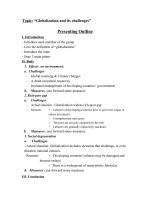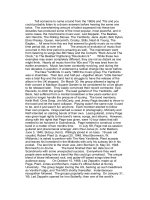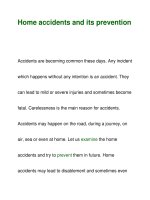Matter and its properties
Bạn đang xem bản rút gọn của tài liệu. Xem và tải ngay bản đầy đủ của tài liệu tại đây (2.23 MB, 10 trang )
Physical Science
by Timothy Sandow
Genre
Nonfiction
Comprehension Skill
Cause and Effect
Text Features
• Captions
• Labels
• Glossary
Science Content
Matter
Scott Foresman Science 3.10
ISBN 0-328-13835-5
ì<(sk$m)=bdidfh< +^-Ä-U-Ä-U
Vocabulary
What did you learn?
atom
1. How can you show that air has volume and takes
up space? by Timothy Sandow
buoyancy
density
element
Matter and Its Properties
2. How are the particles of a solid different than
particles of a liquid or a gas?
mass
3. Where would you look to find out if something is
an element?
matter
4.
In this book you read
about measuring volume. Write to explain
how you would measure the volume of a trunk.
Include details from the book.
5.
Cause and Effect What property
causes an object to float? Describe the effect of
this property.
periodic table
pressure
property
volume
Illustrations: 5, 6, 7 Big Sesh Studios
Photographs: Every effort has been made to secure permission and provide appropriate credit for
photographic material. The publisher deeply regrets any omission and pledges to correct errors called to its
attention in subsequent editions. Unless otherwise acknowledged, all photographs are the property of Scott
Foresman, a division of Pearson Education. Photo locators denoted as follows: Top (T), Center (C), Bottom
(B), Left (L), Right (R) Background (Bkgd)
Opener: ©Taxi/Getty Images; Title Page: ©Photodisc Green/Getty Images; 2 ©Tony Freeman/PhotoEdit;
4 (BC) Corbis, (BR) Brand X Pictures, (BL) Alamy; 5 (BL) ©DK Images
ISBN: 0-328-13835-5
Copyright © Pearson Education, Inc.
All Rights Reserved. Printed in the United States of America. This publication is
protected by Copyright and permission should be obtained from the publisher prior
to any prohibited reproduction, storage in a retrieval system, or transmission in any
form by any means, electronic, mechanical, photocopying, recording, or likewise. For
information regarding permissions, write to: Permissions Department, Scott Foresman,
1900 East Lake Avenue, Glenview, Illinois 60025.
3 4 5 6 7 8 9 10 V010 13 12 11 10 09 08 07 06 05
A property is something about matter that you
How can we describe matter?
can see, hear, touch, or smell. A ball looks round. It
A World of Matter
feels smooth or bumpy. It can be hard or soft. It makes
All of the things you see around you are made of
matter. Matter is anything that takes up space and
a sound when you bounce it. You can smell a flower to
learn about its properties.
has mass. You can sense the mass of an object by how
heavy it feels. You can see that air takes up space
when you blow up a balloon.
2
3
States of Matter
Nearly all matter is a solid, a
Solids
A bowling ball is a solid. Like other solids, it keeps
liquid, or a gas. Each kind of matter
its shape. It stays round. In a solid, all the tiny
is made of very tiny particles. The
particles are packed tightly together. They jiggle very
particles are so small that we
fast, but they stay in place.
cannot see them. The particles are
always moving. In some kinds of
matter, they move a little. In other
kinds of matter, they move a lot.
Solid particles that
jiggle in place
4
5
Gases
Gases do not have a shape. Air is a gas. Tiny gas
particles are not connected to each other. They bounce
off each other as they move freely in space. Unlike
solids and liquids, the amount of space that air takes
up can change.
When air is pumped into a ball, it expands. It
pushes against the inside of the ball. This pushing
Liquid particles that slide
past each other
is called pressure. The air particles get more tightly
pressed together as you pump more air in.
Liquids
Orange juice is a liquid. It takes the shape of the
glass it is in. It will take a new shape if poured into
a different glass. The particles of liquids are loosely
connected. The particles can flow past one another.
What if you poured the juice into a new container? It
will still take up the same amount of space.
6
Gas particles
that bounce off
each other
7
Parts of Matter
Scientists have done experiments to find out how
many different elements there are in matter. Their
What happens if you break a chunk of gold into
smaller pieces? Each particle of gold is still the matter
experiments show that there are more than one
gold. Gold is an element. An element is matter made
hundred different elements. Scientists list all these
of a single type of particle too small to see.
elements in a table. It is called the periodic table of
elements. The elements are placed on the table near
Most matter is made out of many types of particles.
other elements with the same properties.
The smallest particle of an element that has all the
properties of that element is an atom. Gold is made
up only of atoms of gold. Clay
is an example of matter made
State at Room Temperature
Periodic Table of Elements
= Solid
up of different kinds of atoms.
Atoms act together to give
matter its properties.
1
2
H
He
Hydrogen
Helium
5
4
3
7
10
9
8
Be
B
C
N
O
F
Lithium
Beryllium
Boron
Carbon
Nitrogen
Oxygen
Fluorine
12
14
13
16
15
Ne
Neon
18
17
Na
Mg
AI
Si
P
S
CI
Ar
Sodium
Magnesium
Aluminum
Silicon
Phosphorus
Sulfur
Chlorine
Argon
19
21
20
22
23
25
24
28
27
26
30
29
31
32
33
35
34
36
K
Ca
Sc
Ti
V
Cr
Mn
Fe
Co
Ni
Cu
Zn
Ga
Ge
As
Se
Br
Kr
Potassium
Calcium
Scandium
Titanium
Vanadium
Chromium
Manganese
Iron
Cobalt
Nickel
Copper
Zinc
Gallium
Germanium
Arsenic
Selenium
Bromine
Krypton
41
42
43
37
39
38
40
44
45
46
47
48
49
50
52
51
53
54
Rb
Sr
Y
Zr
Nb
Mo
Tc
Ru
Rh
Pd
Ag
Cd
In
Sn
Sb
Te
I
Xe
Rubidium
Strontium
Yttrium
Zirconium
Niobium
Molybdenum
Technetium
Ruthenium
Rhodium
Palladium
Silver
Cadmium
Indium
Tin
Antimony
Tellurium
Iodine
Xenon
74
75
76
83
84
55
56
73
72
71
77
78
79
80
82
81
85
86
Cs
Ba
Lu
Hf
Ta
W
Re
Os
Ir
Pt
Au
Hg
TI
Pb
Bi
Po
At
Rn
Cesium
Barium
Lutetium
Hafnium
Tantalum
Tungsten
Rhenium
Osmium
Iridium
Platinum
Gold
Mercury
Thallium
Lead
Bismuth
Polonium
Astatine
Radon
88
87
103
104
105
106
107
108
109
110
111
112
Fr
Ra
Lr
Rf
Db
Sg
Bh
Hs
Mt
Ds
Rg
Uub
Francium
Radium
Lawrencium
Rutherfordium
Dubnium
Seaborgium
Bohrium
Hassium
Meitnerium
Darmstadtium
Roentgenium
Ununbium
57
58
59
60
61
62
63
64
113
114
115
116
117
118
65
66
67
68
69
70
La
Ce
Pr
Nd
Pm
Sm
Eu
Gd
Tb
Dy
Ho
Er
Tm
Yb
Lanthanum
Cerium
Praseodymium
Neodymium
Promethium
Samarium
Europium
Gadolinium
Terbium
Dysprosium
Holmium
Erbium
Thulium
Ytterbium
91
92
93
94
95
96
89
8
6
Li
11
Clay is made of many
different kinds of atoms.
= Gas
= Liquid
90
97
98
99
100
101
102
Ac
Th
Pa
U
Np
Pu
Am
Cm
Bk
Cf
Es
Fm
Md
No
Actinium
Thorium
Protactinium
Uranium
Neptunium
Plutonium
Americium
Curium
Berkelium
Californium
Einsteinium
Fermium
Mendelevium
Nobelium
9
How are properties of
matter measured?
Tools for Measuring Mass
One property of matter that you can measure
is mass. Mass is the amount of matter an object
has. A balance measures mass. The metric units for
measuring mass are grams (g) and kilograms (kg).
One kilogram has 1,000 grams.
An object’s mass is the same no matter where it
is. But the weight of an object can be different in
different places. Things have different weights on
Tools for Measuring Volume
Another property of matter you can measure is
volume. The volume of an object is the amount of
space that the object takes up. You use a measuring
cup or graduated cylinder to measure the volume of
liquids.
The metric unit for measuring the volume of a
liquid is the liter (L). We can also measure small
amounts of liquid in milliliters (mL). One liter has
1,000 milliliters.
The volume of the milk
in this jug is about 2L.
Earth than they do on the Moon. A scale is used
to measure weight.
A balance measures mass. The whole
toy has the same mass as its parts.
The volume of orange
juice in this bottle is
about 1L.
10
11
Solids have volume, just as liquids do. To measure
the volume of a solid, fill a measuring cup half full
Measuring Density
Density is a measure of the amount of matter
of water. Record the measurement. Now, place a rock
in a certain amount of space. A bowling ball and
into the water. The water rises because the rock has
a rubberball have about the same volume. But the
volume. It takes up space. Look at the water level
bowling ball has more mass and greater density.
now. Record the new measurement. Subtract the first
You can study the density of matter by watching
measurement from the second. The difference in the
how an object floats. How well an object floats in a
water levels is the volume of the rock.
liquid or a gas is called buoyancy. Stones have little
buoyancy in water. They sink because they have a
higher density than water. A helium balloon has lots
of buoyancy in air. It rises because helium has a lower
density than air.
This rubber ball is
the same size as
the bowling ball.
The volume of the water in this
measuring cup is 500 mL.
12
13
Tools for Measuring Other Properties
Size is another property that can be measured. The
distance from one end of something to the other is
its length. The basic unit for measuring length is the
meter (m). We use millimeters (mm) and centimeters
(cm) to measure small things. One meter is 100 cm or
1,000 mm. We use kilometers (km) to measure long
distances. One kilometer is 1,000 meters.
A cubic unit is a cube used to measure volume of a
solid. A cube that is 1 centimeter on all sides has the
volume of 1 cubic centimeter. To find the volume of a
box, put cubes of the same size into the box, and fill it.
The volume of the box is a measurement of how many
cubic units it takes to fill the box.
Some objects are too small to see easily. Use a
magnifying glass to make things look larger. Then
you can see their properties better.
14
15
Glossary
Vocabulary
What did you learn?
atom
atom
the smallest particle of a substance
buoyancy
that has the properties of
density
that substance
buoyancy
how well an object floats in a liquid
element
or rises in air or a gas
mass
density
how much matter is in a certain
matter
amount of space
element
periodic table
a substance made up of a single
pressure
mass
property
volume
matter
object contains
anything that takes up space and
Illustrations: 5, 6, 7 Big Sesh Studios
Photographs: Every effort has been made to secure permission and provide appropriate credit for
photographic material. The publisher deeply regrets any omission and pledges to correct errors called to its
attention in subsequent editions. Unless otherwise acknowledged, all photographs are the property of Scott
Foresman, a division of Pearson Education. Photo locators denoted as follows: Top (T), Center (C), Bottom
(B), Left (L), Right (R) Background (Bkgd)
Opener: ©Taxi/Getty Images; Title Page: ©Photodisc Green/Getty Images; 2 ©Tony Freeman/PhotoEdit;
4 (BC) Corbis, (BR) Brand X Pictures, (BL) Alamy; 5 (BL) ©DK Images
of matter according to their
properties
how hard something presses on
something else
Copyright © Pearson Education, Inc.
property
something about an object that can
All Rights Reserved. Printed in the United States of America. This publication is
protected by Copyright and be
permission
should be obtained from the publisher prior
observed
to any prohibited reproduction, storage in a retrieval system, or transmission in any
form by any means, electronic, mechanical, photocopying, recording, or likewise. For
volume
the amount
of space
an object
information regarding permissions,
write to: Permissions
Department,
Scott Foresman,
1900 East Lake Avenue, Glenview, Illinois 60025.
takes up
3 4 5 6 7 8 9 10 V010 13 12 11 10 09 08 07 06 05
16
3. Where would you look to find out if something is
an element?
4.
In this book you read
about measuring volume. Write to explain
how you would measure the volume of a trunk.
Include details from the book.
5.
Cause and Effect What property
causes an object to float? Describe the effect of
this property.
the amount of matter any
periodic table a table that arranges the elements
ISBN: 0-328-13835-5
2. How are the particles of a solid different than
particles of a liquid or a gas?
type of particle
has weight
pressure
1. How can you show that air has volume and takes
up space?









